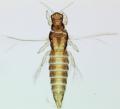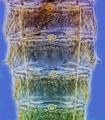Rhipiphorothrips cruentatus
Recognition data
Distinguishing features
Body dark brown, antennae and legs largely yellow, fore wing pale with yellow veins. Head with complex irregular sculpture, with a transverse ridge near posterior and basal reticulate collar; cheeks sharply incut behind eyes and constricted to basal neck. Antennae 8-segmented; segments III & IV with simple sensorium; VIII more than twice as long as VII. Pronotum with no long setae. Mesonotum with complete longitudinal division. Metanotum with well developed reticulate triangle, 1 pair of minute setae near posterior, 1 pair of campaniform sensilla. Tarsi 1-segmented. Fore wing apex rounded with 2 slender cilia; anterior margin with no cilia, posteromarginal cilia straight; veinal setae minute. Abdominal tergites III–VIII with grooved medially, with 1 pair of strong median setae; tergites strongly sculptured laterally; VIII with posteromarginal comb of long microtrichia, absent medially; X with complete longitudinal division; sternal marginal setae minute.
Male with small circular pore plate on anterior margin of sternites III–VII; abdominal segment IV laterally with small pointed tubercle.
Related and similar species
Four species are currently recognised in the genus Rhipiphorothrips. Two little known species from Africa have forked sensoria on antennal segments III & IV, whereas in the two widespread Oriental species these are simple. In R. pulchellus the pronotum is yellow, and the male does not have a tubercle laterally on abdominal segment IV. These four species are remarkable amongst Panchaetothripinae for the curiously irregular sculpture on the head.
Taxonomic data
Current valid name
Rhipiphorothrips cruentatus Hood
Original name and synonyms
- Rhipiphorothrips cruentatus Hood, 1919: 94
- Rhipiphorothrips karna Ramakrishna, 1928: 252
Family placement
Thripidae, Panchaetothripinae
Biological data
Life history
Breeding on leaves, usually on older leaves not newly emerged foliage.
Host plants
Grapes, roses, Anacardium occidentale, Juglans, Syzygium, Terminalia, Ricinus.
Tospoviruses vectored
None
Crop damage
Damaging the leaves of a wide range of plants.
Distribution data
Area of origin
Old World tropics
Distribution
India, Sri Lanka, Pakistan, Afghanistan, but a potential immigrant to the New World in the horticultural trade.







